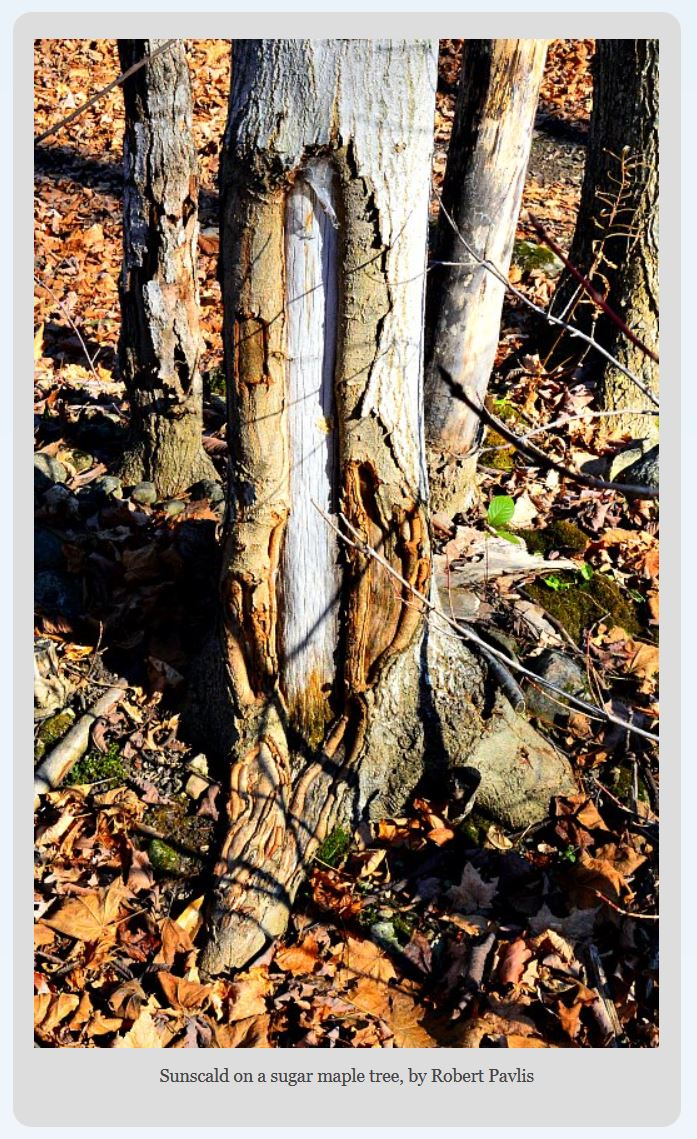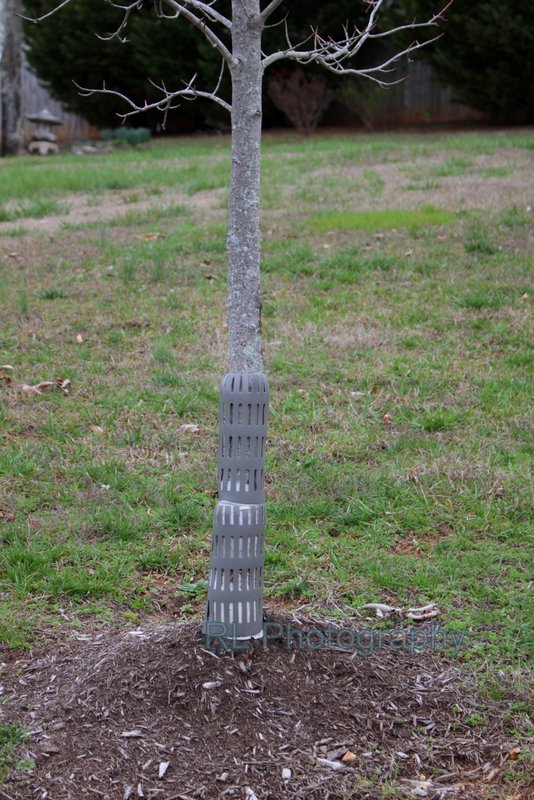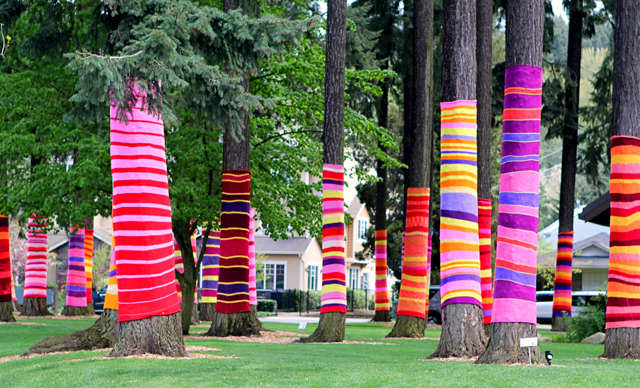Whitewash - It's not only for fences!- by R. Lieber Tom Sawyer may have gotten his friends to whitewash fences, and in some places people are fond of whitewashing homes, windows, floors and outdoor furniture, but what's this about painting trees with white paint? Recently the question was posed about this practice and why it is done. This isn't done much locally, here in Blount County, so many people probably haven't noticed it too much. The question certainly intrigued me enough to read up on the scientific reasons. I had seen rows of white painted orchards on a trip out west but rarely have noticed it in the eastern part of the country. It isn't as common here in East Tennessee as in some other high altitude and/or cold areas of the country (eg Colorado, western Oregon or Utah), but old timers still carry on the tradition for various reasons. In the USA the most common use is for fruit trees, primarily out west, but in some countries, from the Caribbean to South America and even parts of Europe it is simply used to beautify. In some more practical instances the paint is used to make the trees more visible to drivers when they are close to the road. Traditions aside, there are some good reasons to whitewash a tree but the reason it isn't commonplace here in our area is because it rarely makes a difference in our fairly temperate winter and spring. Of course, in recent years we have had some bitter cold and unusually warm winters so for some specimens it would have possibly helped, like my tormented young maple tree which developed the telltale gash on its southwestern side during one of our more harsh winters a few years back.
The single biggest reason that has been backed by some science is the prevention of sunscald on young trees in places where there are rapid swings from below freezing night time temperatures and daytime warm periods with lots of sun. Some people also blame drying winds but research hasn't proven or disproven that. Other names for sunscald include "tree sunburn" and "Southwest Injury." The sunburn is a misnomer and shouldn't be used. Unlike human sunburn the damage is most often something that happens in late winter and there is no burn involved. There is a form of Summer Sunscald that we won't be including in this article. Southwest Injury is far more descriptive since the damage done to trees is generally on the southern to southwestern side of a tree. Sunscald is not caused directly by sap, or sap rising to quickly or too soon in spring, nor is it sap freezing after a long day of warmth. These are a few of the many simplified reasons given. Sunscald happens when a tree partially comes out of dormancy when stronger sunlight warms the bark and outer layers. According to several scientific sources the swing in temperature on this side of the tree can be more than 70 degrees in a day. This warmth signals cells to begin the growth cycle just in the area that has warmed to spring time temperatures. Unfortunately the roots and other parts of the tree are still frozen and/or dormant and the newly active tissue cannot get moisture or nutrients. The reason the color is white is for maximum sun light reflection, just like pale and white clothing does the same for us in summer sunshine. By reducing the heat on the bark the layers that might have been activated by warmth are kept cooler. Between starvation, dehydration and subsequent nights of chilly temperatures, the newly active tissue undergoes necrosis, a slow death of its cells. They are incapable of returning to dormancy just like brand new leaves late in the year cannot go dormant in the face of severe freezes Once the rest of the tree becomes active this area of damaged and dead tree trunk or branch begins to be pulled apart and appears like a gaping wound, often with oozing sap visible. Not only is a cosmetic issue it is also one of leaving the tree open to opportunistic borers and other insect life, as well as infections. Just like an open wound on a human's leg. Other Possible Benefits Even though sunscald is the primary reason to protect with paint, some tree owners and orchard owners have other somewhat compelling reasons. The first is that it creates a barrier of sorts to insects. The claim is it slows or stops borers and other insects from crawling up to higher in the tree. Others simply feel they have a better chance to see the insects on a white background to be able to do something about them. An even more remote benefit is to slow or reduce rodent girdling of the tree bark.
While painting may be the traditional route for those who feel their trees are at risk there are other alternatives. People have tried wrapping tree trunks in cloth or paper as well as newer plastic wraps, attempting to keep insects and rodent damage to a minimum. Paper often does not have the intended effect and can leave the tree open to fungal diseases by keeping the bark continually damp. Plastic tree wraps have become more commonplace and in addition to preventing rodent damage may also provide landscaper damage control by protecting the tree from wayward lawnmowers and weed whackers. The International Society of Arboriculture (ISA) does not recommend wrapping with any of the common plastic, paper or plastics currently available because they are either detrimental or have proven not to keep the underlying temperature changes from occurring. In some cases borer issues have worsened. If wraps are not removed they can also cause harmful growth restriction. It is interesting to note that, based on research at Oklahoma University that a simple renewal of mulch in the late fall has been shown to do more to reduce and prevent sunscald than wraps. Research has also shown hydrated trees are less likely to suffer sunscald.
Tree Friendly Whitewash If you have fruit trees or trees listed in our resources below and want to whitewash them next winter, we have some whitewash ideas for you. Whitewash can be made of different compounds with varying degrees of green friendliness and longevity. For those who don't want to fuss, several brands can be purchased ready made from online sources as well as the usual big box stores. The most common DIY formula is to use an interior latex paint that has been diluted. There are varying formulas to be found online but if you plan on painting a maple tree be aware latex paints have been known to be harmful. Also, I would also not paint a tree with edible fruit on it. Better to err on the side of caution. To make your own Latex based whitewash, the most common formula is given as either 50/50 water to interior latex paint or 75/25 water to interior latex paint mixture. Some sites warn against using exterior latex paint while others seem to recommend it. Exterior latex may be too long wearing to be a healthy cover on a growing (and expanding tree) Others paints are lime based with a formula more or less like the following organic one recommended by Oregon State Extension: Dissolve three pounds of table salt in 12 quarts of water. Then, slowly add and stir in 10 pounds of hydrated lime. Another formula based on a clay called kaolin has been tested and used on fruit trees like apples and is considered a green alternative to many insecticides and fungicides in fruit crops. It is sold as Surround WP. Information: http://extension.usu.edu/files/publications/factsheet/NR_FF_021pr.pdf http://www.gardenmyths.com/sunscald-trees-prevention/ http://extension.oregonstate.edu/gardening/whitewash-tree-trunks-prevent-winter-sun-scald |


 Why Whitewash? Sunscald Prevention (How does it prevent sunscald?)
Why Whitewash? Sunscald Prevention (How does it prevent sunscald?) Alternatives to Whitewash
Alternatives to Whitewash Of course there are also the non horticultural tree covers seen with yarn bombing. As far as I know these zany attempts to beautify city trees and urban structures do not prevent sunscald or keep bugs away. You never know, maybe someday a scientist will discover colorful yarn makes the best organic insect repellent!
Of course there are also the non horticultural tree covers seen with yarn bombing. As far as I know these zany attempts to beautify city trees and urban structures do not prevent sunscald or keep bugs away. You never know, maybe someday a scientist will discover colorful yarn makes the best organic insect repellent!